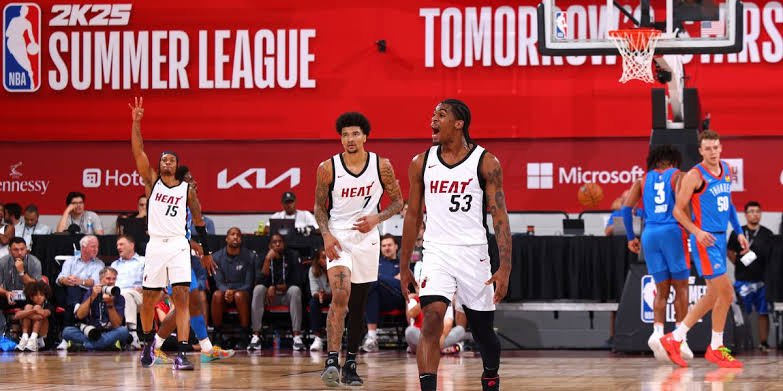The Miami Heat’s 2025 Summer League campaign didn’t end with a trophy, but it might have revealed something more valuable: clarity. The Heat’s young prospects and fringe players battled through inconsistency, pressure, and opportunity—exposing who’s knocking on the door of NBA minutes and who may be slipping off the radar.
With a final record of 4–4, Miami split their performances between the California Classic and Las Vegas Summer League. The games offered a small but intense glimpse into which players are ready for the next level—and which ones have more to prove.
First-round pick Kasparas Jakučionis entered Summer League with buzz and expectations, but left with questions. Despite flashes of skill, he struggled with turnovers, poor shooting, and a concerning inability to create separation off the dribble. At times, he looked overwhelmed by the NBA pace.
Jakučionis’s offensive inconsistency was hard to miss: he shot just 31.8% from the field and 21.4% from three, with 22 turnovers in six games. For a player drafted to be a future lead guard, the performance was disappointing. The hope is that this wake-up call will fuel growth before training camp.
Meanwhile, Kel’el Ware, initially criticized by head coach Erik Spoelstra for his professionalism, flipped the narrative. After a rocky start, Ware responded with two strong showings, displaying defensive versatility and a willingness to play at both the 4 and 5 positions.
Ware’s bounce-back not only salvaged his summer but also revived his case for a rotation spot. His size and mobility showed promise, and his response to coaching adversity could earn him more trust heading into camp.
Vladislav Goldin, the undrafted center out of FAU, was one of the most pleasant surprises of the summer. His rim protection, rebounding, and efficient inside scoring made him look like a natural fit in Miami’s physical system. Though he’s on a two-way contract, his path to the main roster looks very real.
Pelle Larsson arguably stole the show. The second-year guard looked confident, composed, and aggressive—qualities Miami values deeply. He attacked the rim, drew fouls, and made smart reads on both ends. If he continues on this trajectory, he may force his way into meaningful regular-season minutes.
Not everyone, however, made a strong case to stay. Kira Lewis Jr., a former lottery pick, had some bright moments but didn’t do enough to change his trajectory. His play was inconsistent, and he failed to separate himself from the competition.
Keshad Johnson, who had brief playoff minutes last year, also failed to stand out. Fouls, turnovers, and underwhelming stats made it hard to argue for his inclusion on the main roster. His Summer League performance felt more like a stall than a step forward.
On the flip side, Erik Stevenson showed off his three-point shooting and energy. While he may remain a G-League name for now, his play kept him in the Heat’s orbit—especially if they need another shooter down the line.
As training camp approaches, the Summer League revealed what the Heat value most: effort, adaptability, and response to adversity. Miami’s culture doesn’t guarantee comfort. Players must earn every inch—and this summer, several made strides, while others slipped.
The future remains bright, but the competition is fierce. There are no safe bets in Miami—and no comfort zones.
